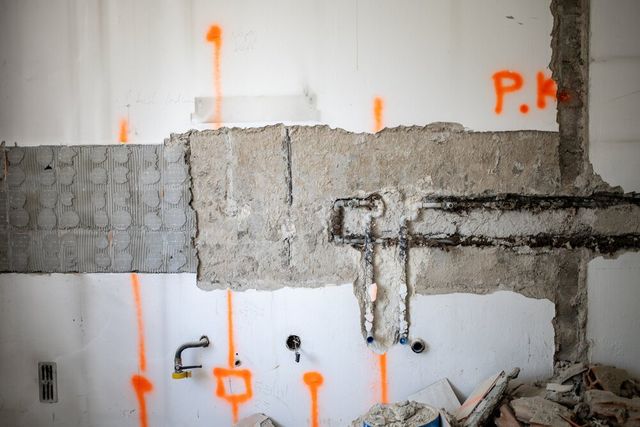Discovering the Midst: A Comprehensive Overview to Concrete Scanning and Its Diverse Applications
In the world of construction and facilities growth, the meticulous procedure of concrete scanning holds a crucial function in guaranteeing the architectural honesty and safety of jobs. As innovation remains to progress, the applications of concrete scanning have actually broadened far past plain surface-level evaluations. From finding rebar and post-tension cables to drawing up avenues and spaces hidden within concrete structures, the capacities of modern-day scanning methods are both essential and excellent. The true depth of concrete scanning's potential reaches also further, branching right into unforeseen sectors and stimulating cutting-edge solutions. The interconnected internet of possibilities that concrete scanning offers is not just fascinating yet also crucial for the development of various industries.
Value of Concrete Scanning
Comprehending the importance of concrete scanning is crucial in ensuring the safety and security and stability of structures throughout building and remodelling jobs. Concrete scanning utilizes innovative modern technologies such as ground-penetrating radar (GPR) and electro-magnetic induction to identify embedded objects, voids, or other abnormalities within concrete frameworks.
Moreover, concrete scanning plays a crucial role in making certain conformity with building regulations and policies that mandate the security of existing structural elements during building tasks. By precisely drawing up the internal make-up of concrete, scanning innovations allow building experts to make enlightened choices that maintain the structural security and resilience of buildings and infrastructure tasks. Fundamentally, the relevance of concrete scanning exists in its ability to guard both the architectural integrity and the personnel associated with construction endeavors.
Technologies Utilized in Concrete Scanning
Concrete scanning depends on sophisticated modern technologies such as ground-penetrating radar (GPR) and electro-magnetic induction to precisely spot ingrained things and anomalies within concrete structures. Ground-penetrating radar operates by giving off high-frequency electromagnetic waves into the concrete.
Electro-magnetic induction, on the various other hand, works by creating magnetic fields around a concrete framework via a transmitter coil. When metal things exist within the concrete, they disrupt these magnetic fields, causing eddy currents to stream through the metal. By measuring the adjustments in the electro-magnetic fields with a receiver coil, the system can determine the area of metal items in the concrete.
These cutting-edge innovations play an essential role in non-destructive testing, making sure the security and integrity of concrete structures in different markets.
Applications in Building And Construction Industry
Within the construction industry, concrete scanning innovation finds varied applications that enhance project effectiveness and safety. In addition, concrete scanning is used for locating voids, such as air pockets or locations of damage within concrete, which can endanger the general stamina of a framework. Concrete scanning plays a vital function in top quality control by confirming the density of concrete covers over support, making certain conformity with layout requirements and criteria.

Safety And Security Advantages of Concrete Scanning
In the realm of construction security, the execution of concrete scanning modern technology provides read this post here a paramount benefit in preemptively identifying possible dangers and strengthening structural honesty. By utilizing innovative scanning techniques such as ground-penetrating radar (GPR) and electromagnetic induction, building teams can properly find rebar, post-tension cable televisions, channels, and various other surprise items within concrete frameworks. This aggressive method substantially lowers the threat of accidental strikes during boring, cutting, or coring activities, thereby avoiding costly damages, injuries, and job hold-ups.
Additionally, concrete scanning enhances employee security by supplying real-time information concerning the architectural condition of concrete aspects. By attending to possible safety issues quickly, concrete scanning adds to producing a safe functioning atmosphere and reducing the chance of structural failures or mishaps on construction websites.
Future Patterns in Concrete Scanning
Arising try this innovations in scanning modern technology are poised to revolutionize the field of concrete evaluation and evaluation. By using the power of AI, these systems can evaluate huge quantities of data gathered during scanning processes to give even more detailed and accurate understandings into the problem of concrete frameworks.
One more substantial fad is the growth of more straightforward and mobile scanning tools. Miniaturization of scanning tools enables easier accessibility to restricted spaces and remote places, making inspections much more effective and comprehensive. Furthermore, advancements in cordless communication modern technologies allow real-time data transfer and analysis, promoting quicker decision-making processes.
Furthermore, there is dig this a growing focus on sustainability in concrete scanning technologies - RainierGPR Concrete Scanning. Suppliers are increasingly incorporating green materials and energy-efficient features into their devices to minimize environmental impact. These future trends are readied to enhance the performance, precision, and sustainability of concrete scanning practices, shaping the market's future landscape
Verdict
In conclusion, concrete scanning plays a vital duty in the construction sector by guaranteeing the safety and security and performance of various jobs. As modern technology advancements, the future of concrete scanning holds encouraging growths for improving construction procedures.
